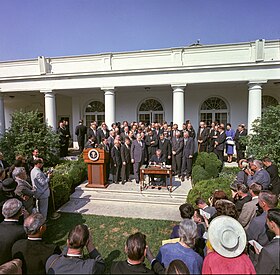
Back الحرب على الفقر Arabic Guerra contra la pobreza Spanish Guerre contre la pauvreté French Perang melawan kemiskinan ID Війна з бідністю Ukrainian

The war on poverty is the unofficial name for legislation first introduced by United States President Lyndon B. Johnson during his State of the Union Address on January 8, 1964. This legislation was proposed by Johnson in response to a national poverty rate of around nineteen percent. The speech led the United States Congress to pass the Economic Opportunity Act, which established the Office of Economic Opportunity (OEO) to administer the local application of federal funds targeted against poverty. The forty programs established by the Act were collectively aimed at eliminating poverty by improving living conditions for residents of low-income neighborhoods and by helping the poor access economic opportunities long denied from them.[1]
As a part of the Great Society, Johnson believed in expanding the federal government's roles in education and health care as poverty reduction strategies.[2] These policies can also be seen as a continuation of Franklin D. Roosevelt's New Deal, which ran from 1933 to 1937, and Roosevelt's Four Freedoms of 1941. Prior to John F. Kennedy's assassination in November 1963, Kennedy planned on proposing anti-poverty legislation in the 1964 State of the Union address that Johnson ended up giving.[3] In that address, Johnson stated, "Our aim is not only to relieve the symptom of poverty, but to cure it and, above all, to prevent it".[4]
The war on poverty was heavily criticized by conservatives and has been treated as an "idealistic touchstone" by liberals for decades, although some liberals felt that the war on poverty did not go far enough with its reforms.[5] Deregulation, growing criticism of the welfare state, and an ideological shift to reducing federal aid to impoverished people in the 1980s and 1990s culminated in the Personal Responsibility and Work Opportunity Act of 1996, which President Bill Clinton claimed "ended welfare as we know it." The legacy of the war on poverty policy initiative remains in the continued existence of such federal government programs as Head Start, Volunteers in Service to America (VISTA), TRiO, and Job Corps.
The official poverty rate has fallen from 19.5% in 1963 to 10.5% in 2019 while other measures of poverty show that the poverty rate fell from 19.5% to 1.6%.[6] In 2021 the official poverty rate was 11.6% and Supplemental Poverty Measure (SPM) was 7.8%, the latter which increased to 12.4% in 2022 due to the end of pandemic aid.[7][8]
- ^ Caves, R. W. (2004). Encyclopedia of the City. Routledge. p. 759. ISBN 978-0415862875.
- ^ These justifications and aspects of the war on poverty are discussed in Weisbrod, Burton, ed. The Economics of Poverty: An American Paradox, Prentice-Hall, 1965
- ^ Schlesinger Jr., Arthur M. (1965). A Thousand days: John F Kennedy in the White House. Houghton Mifflin. p. 1012. ISBN 0-618-21927-7.
- ^ Rector, Robert; Sheffield, Rachel (September 15, 2014). "The War on Poverty After 50 Years". The Heritage Foundation. Archived from the original on May 15, 2015.
- ^ "War on Poverty". Encyclopædia Britannica. Retrieved August 15, 2022.
- ^ Burkhauser, Richard V.; Corinth, Kevin; Elwell, James; Larrimore, Jeff (2024). "Evaluating the Success of the War on Poverty since 1963 Using an Absolute Full-Income Poverty Measure". Journal of Political Economy. 132: 1–47. doi:10.1086/725705. ISSN 0022-3808. S2CID 258470547.
- ^ Rank, Mark Robert (2023). The Poverty Paradox: Understanding Economic Hardship Amid American Prosperity. Oxford University Press. p. 15. ISBN 978-0190212636.
- ^ Picchi, Aimee (September 12, 2023). "America's poverty rate soared last year. Children were among the worst hit". CBS News. Retrieved November 28, 2023.